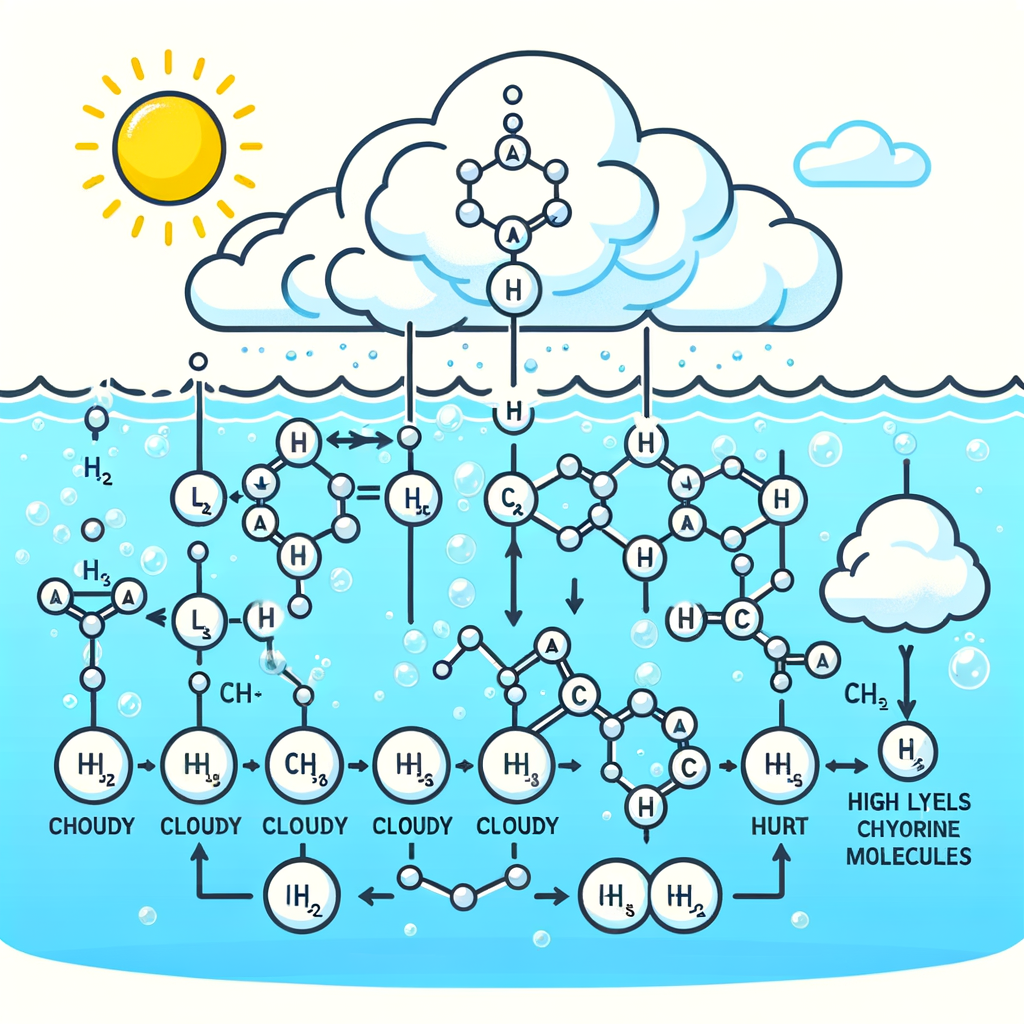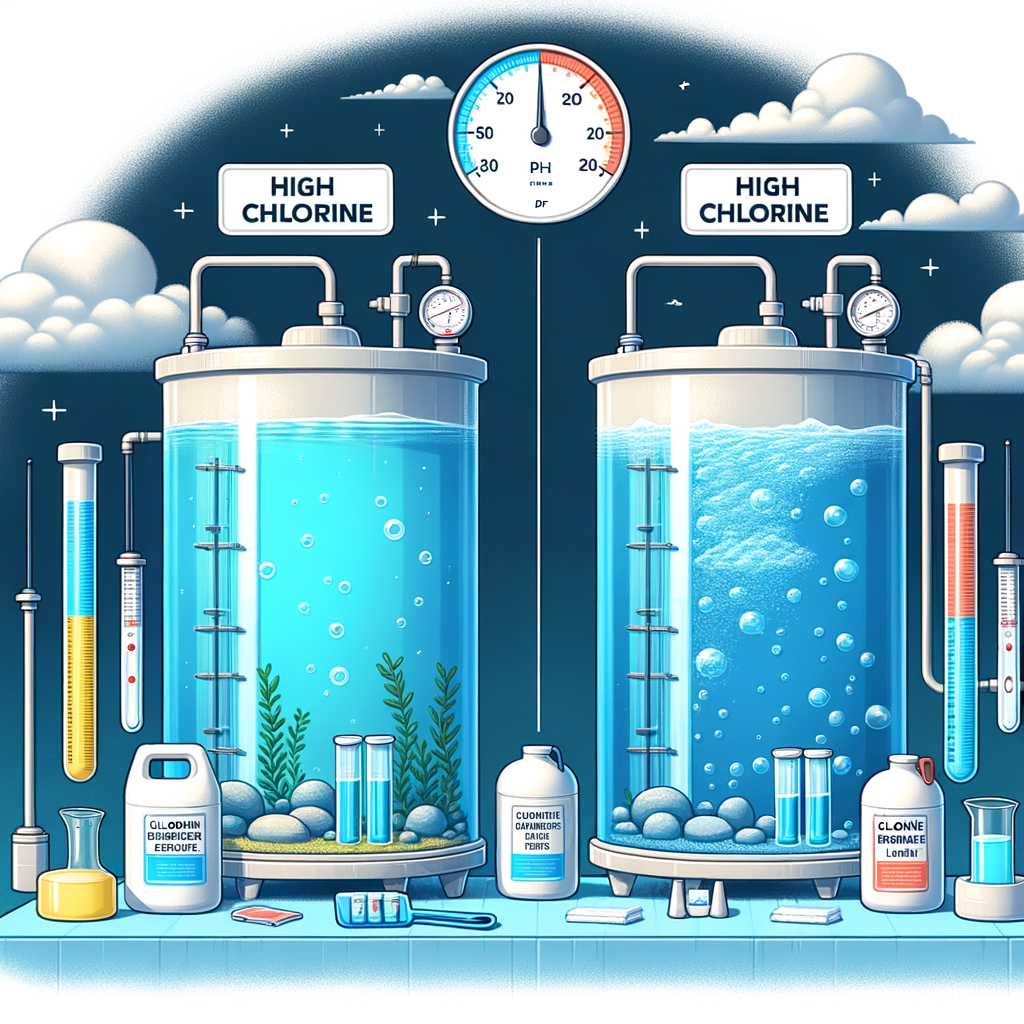
“High Chlorine, Cloudy Waters: Balance is Key for Crystal Clear Pools!”
Table of Contents
Introduction
High chlorine levels in swimming pools or other water systems can indeed cause cloudy water. Chlorine is commonly used as a disinfectant to kill harmful bacteria and pathogens, ensuring the water remains safe for use. However, when chlorine levels become excessively high, it can lead to a range of issues, including cloudiness. This cloudiness is often the result of chemical imbalances, where the excess chlorine reacts with other substances in the water, such as organic matter, minerals, and other pool chemicals.
These reactions can produce tiny particles that remain suspended in the water, scattering light and giving the water a cloudy appearance. Additionally, high chlorine levels can also disrupt the pH balance of the water, further contributing to turbidity. Therefore, maintaining appropriate chlorine levels is crucial for both the clarity and safety of the water.
The Science Behind Cloudy Water: Effects of Excessive Chlorine

cloudy water in swimming pools is a common issue that can be both frustrating and perplexing for pool owners. While there are numerous factors that can contribute to this problem, one often overlooked cause is the presence of high chlorine levels. Understanding the science behind cloudy water and the effects of excessive chlorine is essential for maintaining a clear and healthy swimming environment.
Chlorine is a vital chemical in pool maintenance, primarily used for its disinfectant properties. It effectively kills bacteria, viruses, and other pathogens, ensuring that the water remains safe for swimmers. However, when chlorine levels exceed the recommended range, it can lead to unintended consequences, including cloudy water. This phenomenon occurs due to a series of chemical reactions and physical changes within the pool water.
To begin with, high chlorine levels can cause an imbalance in the pool’s pH levels. Chlorine is inherently acidic, and when added in excess, it can lower the pH of the water. A low pH level can lead to the dissolution of minerals and metals from pool surfaces and equipment, which then become suspended in the water, contributing to its cloudiness. Moreover, an imbalanced pH can reduce the effectiveness of chlorine as a disinfectant, creating a vicious cycle where more chlorine is added to compensate, further exacerbating the problem.
In addition to pH imbalances, excessive chlorine can react with organic matter present in the pool, such as sweat, body oils, and debris. These reactions produce chloramines, compounds that are less effective as disinfectants and can cause irritation to the eyes and skin. Chloramines also contribute to the cloudiness of the water by forming tiny particles that scatter light, giving the water a milky appearance. Furthermore, the presence of chloramines is often accompanied by a strong chlorine odor, which is another indicator of high chlorine levels.
Another factor to consider is the interaction between chlorine and other pool chemicals. For instance, high levels of chlorine can cause calcium hardness to increase. When calcium levels become too high, calcium carbonate precipitates out of the water, forming tiny particles that remain suspended and create a cloudy appearance. This is particularly problematic in areas with hard water, where calcium levels are naturally elevated.
Moreover, high chlorine levels can disrupt the effectiveness of algaecides and other water clarifiers. These chemicals are designed to work within a specific range of chlorine concentrations, and when this range is exceeded, their efficacy diminishes. As a result, algae and other microorganisms may proliferate, further contributing to the cloudiness of the water.
To mitigate the issue of cloudy water caused by high chlorine levels, it is crucial to regularly test and monitor the pool’s chemical balance. Maintaining chlorine levels within the recommended range, typically between 1 and 3 parts per million (ppm), is essential. Additionally, ensuring that the pH level remains between 7.2 and 7.8 will help prevent the dissolution of minerals and the formation of chloramines. Regularly cleaning the pool and removing organic debris can also reduce the demand for chlorine, minimizing the risk of over-chlorination.
In conclusion, while chlorine is indispensable for maintaining a safe swimming environment, excessive levels can lead to cloudy water through a series of chemical reactions and imbalances. By understanding the science behind these processes and taking proactive measures to maintain proper chemical levels, pool owners can ensure that their water remains clear and inviting.
Troubleshooting Cloudy Water: Is High Chlorine the Culprit?
When troubleshooting cloudy water in a swimming pool, one might wonder if high chlorine levels are the primary cause. Understanding the relationship between chlorine levels and water clarity is essential for effective pool maintenance. Chlorine is a critical component in maintaining a clean and safe swimming environment, as it helps to eliminate harmful bacteria and other contaminants. However, the balance of chlorine must be carefully managed, as both insufficient and excessive levels can lead to various issues, including cloudy water.
To begin with, it is important to recognize that high chlorine levels are not typically the direct cause of cloudy water. In fact, chlorine is generally responsible for keeping the water clear by oxidizing organic matter and killing pathogens. Nevertheless, excessively high chlorine levels can contribute to cloudiness indirectly. For instance, when chlorine levels are too high, it can lead to the formation of chloramines, which are compounds created when chlorine reacts with ammonia and organic nitrogen compounds. Chloramines are less effective at sanitizing the water and can cause irritation to swimmers’ eyes and skin, as well as contribute to a cloudy appearance.
Moreover, high chlorine levels can also affect the pool’s pH balance. Chlorine is inherently acidic, and when added in large quantities, it can lower the pH of the water. A low pH level can cause calcium to precipitate out of the water, leading to calcium carbonate deposits that make the water appear cloudy. Therefore, maintaining the correct pH balance is crucial in preventing cloudiness and ensuring the effectiveness of chlorine as a sanitizer.
In addition to the potential issues caused by high chlorine levels, other factors can contribute to cloudy water. For example, inadequate filtration and circulation can prevent debris and contaminants from being properly removed from the water. It is essential to ensure that the pool’s filtration system is functioning correctly and that the water is circulating effectively. Regularly cleaning the filter and checking for any blockages can help maintain water clarity.
Furthermore, environmental factors such as heavy rainfall, high bather loads, and the presence of algae can also lead to cloudy water. Rainwater can introduce additional contaminants and alter the chemical balance of the pool, while a high number of swimmers can increase the amount of organic matter and debris in the water. Algae growth, often caused by insufficient chlorine levels or poor circulation, can also contribute to cloudiness. Addressing these factors through proper pool maintenance and chemical management is essential in preventing and resolving cloudy water issues.
In conclusion, while high chlorine levels are not typically the direct cause of cloudy water, they can contribute to the problem indirectly by affecting the pH balance and leading to the formation of chloramines. It is important to maintain the correct chlorine levels and pH balance to ensure clear and safe swimming water. Additionally, addressing other potential causes such as inadequate filtration, environmental factors, and algae growth is crucial in troubleshooting and resolving cloudy water issues. By understanding the various factors that can contribute to cloudiness and taking appropriate measures, pool owners can maintain a clean and inviting swimming environment.
Preventing Cloudy Water: Managing Chlorine Levels in Your Pool
Maintaining a pristine, clear pool is a priority for many pool owners, and understanding the role of chlorine in this process is crucial. Chlorine is a powerful disinfectant that helps keep pool water free from harmful bacteria and algae. However, while it is essential for maintaining water quality, improper management of chlorine levels can lead to unintended consequences, such as cloudy water. This phenomenon can be perplexing, as chlorine is typically associated with cleanliness and clarity. Therefore, it is important to explore how high chlorine levels can contribute to cloudiness and what steps can be taken to prevent this issue.
Firstly, it is essential to recognize that chlorine, when used in appropriate amounts, is highly effective in sanitizing pool water. It works by breaking down organic matter and neutralizing pathogens, ensuring a safe swimming environment. However, when chlorine levels become excessively high, it can lead to a series of chemical reactions that result in cloudy water. One of the primary reasons for this is the formation of chloramines, which occur when chlorine combines with nitrogen-containing compounds such as sweat, urine, and other organic debris introduced by swimmers. Chloramines not only reduce the effectiveness of chlorine but also contribute to water cloudiness and an unpleasant odor.
Moreover, high chlorine levels can cause an imbalance in the pool’s pH levels. Chlorine is inherently a strong oxidizer, and when present in large quantities, it can lower the pH of the water, making it more acidic. This acidic environment can lead to the dissolution of minerals and metals from pool surfaces and equipment, which then become suspended in the water, causing it to appear cloudy. Additionally, an imbalanced pH can irritate swimmers’ skin and eyes, further detracting from the overall swimming experience.
To prevent cloudy water caused by high chlorine levels, it is imperative to regularly monitor and adjust the pool’s chemical balance. Utilizing a reliable pool testing kit, pool owners should frequently check the chlorine concentration, pH levels, and total alkalinity. The ideal chlorine level for a pool is typically between 1 and 3 parts per million (ppm). If the chlorine level exceeds this range, it is advisable to reduce it by diluting the pool water with fresh water or using a chlorine neutralizer. Maintaining a pH level between 7.2 and 7.6 is also crucial, as this range ensures optimal chlorine efficacy and minimizes the risk of cloudiness.
In addition to chemical management, proper pool maintenance practices play a significant role in preventing cloudy water. Regularly cleaning the pool by skimming debris, brushing the walls and floor, and vacuuming can help reduce the organic load that contributes to chloramine formation. Ensuring that the pool’s filtration system is functioning efficiently is equally important, as it aids in removing suspended particles and contaminants from the water. Backwashing the filter and replacing it as needed can enhance its performance and contribute to clearer water.
Furthermore, educating swimmers about proper pool hygiene can significantly reduce the introduction of contaminants that lead to chloramine formation. Encouraging showering before entering the pool and discouraging urination in the water can help maintain a cleaner swimming environment.
In conclusion, while chlorine is indispensable for maintaining pool water quality, managing its levels is crucial to prevent cloudiness. By regularly monitoring and adjusting chemical balances, performing routine maintenance, and promoting good swimmer hygiene, pool owners can ensure that their pools remain clear and inviting. Understanding the delicate balance of chlorine and its interactions with other factors is key to achieving and maintaining the ideal swimming conditions.

Understanding How High Chlorine Levels Cause Cloudy Water
Chlorine is a fundamental component in maintaining the cleanliness and safety of swimming pools. It acts as a powerful disinfectant, eliminating harmful bacteria and pathogens that can pose health risks to swimmers. However, while chlorine is essential for pool maintenance, an imbalance in its levels can lead to unintended consequences, one of which is cloudy water. Understanding how high chlorine levels cause cloudy water requires a closer examination of the chemical interactions and physical processes involved.
To begin with, it is important to recognize that chlorine, when added to pool water, undergoes a series of chemical reactions. These reactions produce hypochlorous acid and hypochlorite ions, which are responsible for the sanitizing effects. However, when chlorine levels become excessively high, these reactions can lead to the formation of chloramines. Chloramines are compounds formed when chlorine combines with nitrogen-containing substances, such as sweat, urine, and other organic matter introduced by swimmers. These compounds not only reduce the effectiveness of chlorine as a disinfectant but also contribute to water cloudiness.
Moreover, high chlorine levels can disrupt the delicate balance of pool water chemistry. Pool water is a complex solution that requires careful management of various parameters, including pH, alkalinity, and calcium hardness. When chlorine levels are elevated, it can cause fluctuations in pH levels, often leading to a decrease in pH. Low pH levels can result in the dissolution of calcium compounds in the water, which then precipitate out as calcium carbonate. This precipitation manifests as tiny particles suspended in the water, giving it a cloudy appearance.
In addition to chemical imbalances, high chlorine levels can also affect the physical filtration process. Pool filters are designed to remove particulate matter and debris from the water, ensuring clarity and cleanliness. However, excessive chlorine can lead to the formation of larger particles through a process known as coagulation. These larger particles can overwhelm the filtration system, reducing its efficiency and allowing more particles to remain suspended in the water. Consequently, the water becomes cloudy as the filtration system struggles to keep up with the increased load.
Furthermore, it is worth noting that high chlorine levels can have a detrimental impact on the pool’s overall ecosystem. Beneficial microorganisms that contribute to the natural balance of the pool environment can be adversely affected by excessive chlorine. This disruption can lead to an increase in organic matter, such as algae and bacteria, which further contributes to water cloudiness. The presence of these microorganisms not only affects water clarity but also poses potential health risks to swimmers.
In conclusion, while chlorine is indispensable for maintaining a clean and safe swimming pool, it is crucial to monitor and regulate its levels carefully. High chlorine levels can lead to the formation of chloramines, disrupt water chemistry, overwhelm filtration systems, and disturb the pool’s natural ecosystem. These factors collectively contribute to the phenomenon of cloudy water. Therefore, pool owners and operators must adopt a balanced approach to chlorine management, ensuring that levels are kept within the recommended range to maintain both water clarity and swimmer safety. By understanding the intricate relationship between chlorine levels and water cloudiness, one can take proactive measures to prevent and address this common issue effectively.
Q&A
1. **Question:** Can high chlorine levels cause cloudy water in a pool?
**Answer:** Yes, high chlorine levels can cause cloudy water in a pool.
2. **Question:** What is one reason high chlorine levels might make pool water cloudy?
**Answer:** High chlorine levels can cause calcium to precipitate out of the water, leading to cloudiness.
3. **Question:** How can high chlorine levels affect pool water chemistry?
**Answer:** High chlorine levels can disrupt the balance of other chemicals in the pool, such as pH and alkalinity, contributing to cloudy water.
4. **Question:** What is a potential consequence of high chlorine levels on pool filtration?
**Answer:** High chlorine levels can damage the pool filter media, reducing its effectiveness and potentially leading to cloudy water.
Conclusion
High chlorine levels can cause cloudy water because excessive chlorine can react with organic and inorganic materials in the water, leading to the formation of chloramines and other compounds that contribute to turbidity. Additionally, high chlorine levels can disrupt the balance of other chemicals in the water, further contributing to cloudiness. Therefore, maintaining appropriate chlorine levels is essential for clear water.

